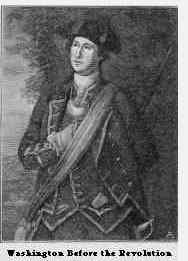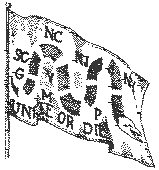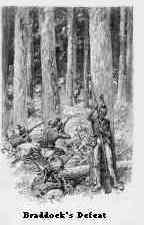Resource Center OLLibrary
|
116 |
|
[1745-1754 |
of New England, and full of faith in New England grit, he wrote
to his brother that Louisburg was far too hard a nut for their
teeth to crack. But, with the help of a British fleet, Pepperrell
and his men, after six weeks' fighting, did crack it (1745), and
Boston fairly went wild over the great news.1 The
victory had two important results:
1. It broke up the nest of French pirates at
Louisburg, and so put an end to their capturing and plundering
Massachusetts fishing vessels.
2. It made the New England people feel that they
could beat the French even when they had granite walls, to protect
them.

TAKING OF LOUISBURG -- DRAGGING THE GUNS ACROSS THE MARSH
At the end of the war England gave Louisburg
back to France; but she could not give back the confidence the
French once had in the famous fortress. The "Yankees" had taken
it; and what men have done, they can do again.
136. The Fourth or "French and Indian War";
the Great Line of French Forts. The fourth and final struggle
(1754-1763) was known as the "French and Indian War." It was
fought to decide the great question whether the French or the
English should control the continent of America.
The English outnumbered the French fifteen to
one; but the French had got possession of the two chief rivers of
the country, the St. Lawrence and the Mississippi (§§
48, 131, 133). To
1 Notwithstanding the
bravery of Pepperrell and his gallant little force, it is not
likely that they, even with the help of the British fleet, could
have taken Louisburg had that fort possessed an efficient garrison
and a competent commander. It had neither, and hence it fell.
England was astonished, and the King was so delighted that he made
the American commander a baronet, -- Sir William Pepperrell. He
was the first native of New England who received that honor;
though William Phips (§ 134) had been knighted more than
fifty years before.
|
1753-1754 ] |
|
117 |
clinch their hold they built fort after fort, until they had a
line extending from Quebec to the Great Lakes, and thence down the
Wabash, the Illinois, and the Mississippi to the Gulf. (Map, p.
111.) Where many of those and succeeding forts stood, flourishing
cities have since risen, which still keep the old French or Indian
names of Detroit, Chicago, St. Louis, Natchez, New Orleans. That
shows the forethought of the French explorers. When they selected
a spot to fortify, they seem to have thought not only of its
military strength but also of the possibilities of its growth as a
center of business and commerce.
137. The Ohio Company; Governor Dinwiddie's
Messenger. But at last the English began to open their eyes to
the danger which threatened them. They saw that unless they moved
into the rich territory west of the Alleghenies, they would lose
the heart of the continent and the French would have everything
their own way. To prevent such a disaster. the Ohio Company was
formed in Virginia (1748), to plant a colony of emigrants on the
cast bank of the upper Ohio.1
The French at once resolved to stop the
movement, and began a new line of forts, extending southward from
Erie on Lake Erie to the point where the Allegheny and the
Monongahela rivers unite to form the Ohio. That point at the head
of inland navigation was called the "Gateway of the West." Both
parties knew its importance; both meant to seize and fortify it.
(Map, p. 114.)
Governor Dinwiddie of Virginia determined (1753)
to send a messenger to Venango, -- one of the new French forts, --
and warn off the intruders.2 Whoever undertook such a
journey must travel at least three hundred miles on foot, climb a
succession of mountain ranges, cross rivers as best he could, and
risk his life among hostile Indians.
1 The first Ohio
Company (1748), whose chief manager, Lawrence Washington, brother
of George Washington, died in 1752, received a grant of 500,000
acres on the east bank of the Ohio, between the Great Kanawha and
the Monongahela rivers. The region is now embraced by West
Virginia and southwest Pennsylvania.
2 The English maintained that they
had purchased the Ohio Valley region of the Iroquois Indians, who
declared that they had conquered it many years before. There is no
evidence that the Iroquois had any right to sell the
land.
|
118 |
|
[1753 |
|
The Governor finally decided to
intrust this difficult and dangerous work to the brother
of the late |
|
1754 ] |
|
119 |
|
life he used his influence in every way to build roads
and canals to open up and settle the "West," or what was
then known by that name. |
|
120 |
|
[1755 |
|
authorities in England "dreaded American union as the
keystone of independence." 1 |
|
1697-1748 ] |
|
121 |
it seemed a cruel thing at the time, but apparently the English
had to do it.'
William Pitt, later known as Lord Chatham, had
now become the chief councilor in the English government. He was
one of the truest friends that America ever had. He sent fresh
troops to fight for the colonists, and the English recaptured and
held the famous fort at Louisburg (§ 135).
A second expedition, in which Colonel Washington
again took part (§ 140), attacked Fort Duquesne. The fort was
taken and named Fort Pitt, in honor of the distinguished statesman
who had made the victory possible. To-day we know the place as
Pittsburgh, the center of the most extensive iron works in the
United States.
The victory gave the English the control of the
Ohio country, and drove the French back to Canada.
142. Fall of Quebec (1759); Pontiac's
Conspiracy. The French had lost Fort Frontenac, now Kingston,
Canada (Map. p. 111), but they still held the formidable
stronghold of Quebec. This fortress -- the "Gibraltar of America"
-- was built on a lofty rock, overlooking the St. Lawrence.
Montcalm, one of the ablest and noblest generals of France, was
commander of the fortress. General Wolfe, an English soldier of
equal character and courage, resolved to wrest it from him. He had
only a few thousand men, a part of whom were American colonists,
but every one of these men believed in him heart and soul. They
believed, too, just as much in the "Hot Stuff" which Wolfe gave
the enemy.2
The death struggle came when Wolfe, with his
troops, climbed up from the river to the top of the lofty plain
called the Heights
1 Longfellow has made
this exile of the 7000 Acadians the subject of his poem of
"Evangeline." Burke called the expulsion "an inhuman act," but
recent investigation seems to show that the English were justified
in driving out the French, since they positively refused to take
the oath of allegiance to England, and their sons were secretly
fighting against her (see Parkman's "Montcalm and Wolfe," I,
234-284)
2 Among the rousing battle songs sung
by Wolfe's men was one about Hot Stuff," which began with this
appeal:
Come, each death-daring dog who dares venture his neck,
Come, follow the hero that goes to Quebec;And ye that love fighting shall soon have enough:
Wolfe commands us, my boys; we shall give them 'Hot Stuff.'"
 chief
manager of the Ohio Company, a young man of twenty-one,
who was a skillful surveyor, knew all about life in the
wilderness, and did not know what fear meant. The name of
that young man may still be read on a lofty limestone
cliff of the Natural Bridge in Virginia, where, when a
lad, he climbed up higher than any of his companions
dared to go, and cut it with his hunting knife, --
GEORGE
WASHINGTON.1
chief
manager of the Ohio Company, a young man of twenty-one,
who was a skillful surveyor, knew all about life in the
wilderness, and did not know what fear meant. The name of
that young man may still be read on a lofty limestone
cliff of the Natural Bridge in Virginia, where, when a
lad, he climbed up higher than any of his companions
dared to go, and cut it with his hunting knife, --
GEORGE
WASHINGTON.1 accepted
the challenge and began to build a fort at the "Gateway
of the West" (§ 137); but the French drove them out,
finished building it, and named it Fort Duquesne in honor
of the French governor of Canada. Washington then began a
small fort, which he called Fort Necessity, about forty
miles south of Fort Duquesne; but the French came in
overwhelming force, and compelled him to surrender it.
(Map, p. 114 .)
accepted
the challenge and began to build a fort at the "Gateway
of the West" (§ 137); but the French drove them out,
finished building it, and named it Fort Duquesne in honor
of the French governor of Canada. Washington then began a
small fort, which he called Fort Necessity, about forty
miles south of Fort Duquesne; but the French came in
overwhelming force, and compelled him to surrender it.
(Map, p. 114 .) 140.
Braddock's Defeat; Washington. The next year (1755)
General Braddock came from England with troops to drive
the French and Indians out of the Ohio Valley. He
advanced from Alexandria, Virginia, across the mountains
to attack Fort Duquesne 138). (Map, p. 114.) Washington
accompanied him. All went well until the British army had
nearly reached the fort. Suddenly a savage yell rose from
the woods through which the men were marching, followed
by a murderous volley of bullets which killed many. The
English general was mortally wounded. A panic set in; his
men ran like sheep, and were shot down as they ran. A few
days later Braddock died, and was secretly buried at
night. Colonel Washington read the funeral service over
his grave by torch light.
140.
Braddock's Defeat; Washington. The next year (1755)
General Braddock came from England with troops to drive
the French and Indians out of the Ohio Valley. He
advanced from Alexandria, Virginia, across the mountains
to attack Fort Duquesne 138). (Map, p. 114.) Washington
accompanied him. All went well until the British army had
nearly reached the fort. Suddenly a savage yell rose from
the woods through which the men were marching, followed
by a murderous volley of bullets which killed many. The
English general was mortally wounded. A panic set in; his
men ran like sheep, and were shot down as they ran. A few
days later Braddock died, and was secretly buried at
night. Colonel Washington read the funeral service over
his grave by torch light.


